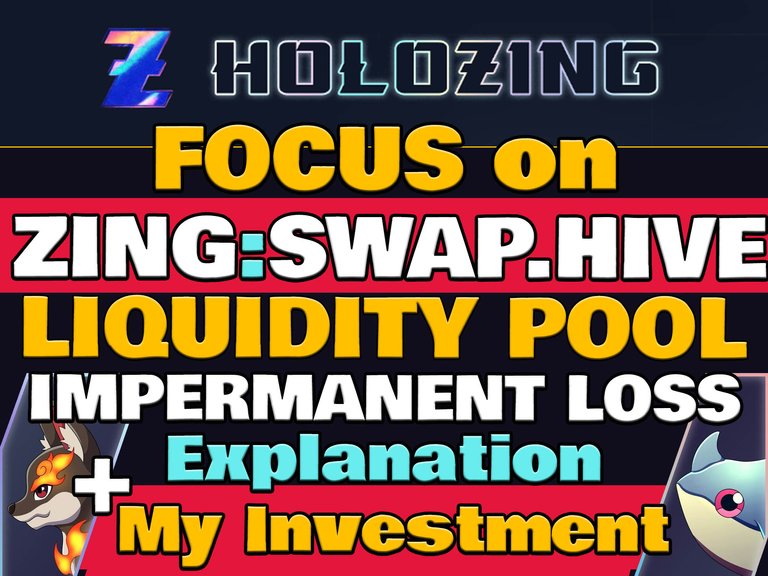


Holozing: Focus on ZING:SWAP.HIVE Liquidity Pool + Impermanent Loss Explanation and Examples + My LP Investment Analysis

Today I am returning to write about HOLOZING which is a Hive game project under development that I am very interested in.

The founder of Holozing is @acidyo and by clicking on the following link you can see the team members working on this project: https://whitepaper.holozing.com/the-game/team
Although it is not yet possible to play Holozing, it is possible to participate in the distribution of Holozing's native tokens: the ZING tokens.
ZING tokens are distributed via a claimdrop on an hourly basis and in the table below you can see the total amount of ZING tokens distributed daily, monthly and annually.

In my previous post, I calculated the best and cheapest way to earn ZING tokens based on the different options you can choose and also shared my basic strategy for accumulating ZING tokens.
 | Post Link: Holozing: The Best and Cheapest Way to Earn ZING tokens! + My Strategy (ENG/ITA) |
|---|
In today's post, my focus is on the ZING:SWAP.HIVE pool, and the topics of my post are:
- How to add and remove liquidity from the pool ZING:SWAP.HIVE.
- What is impermanent loss
- Why invest in a liquidity pool?
- The financial analysis of my investment in the ZING:SWAP.HIVE pool.

How to add and remove liquidity from the pool ZING:SWAP.HIVE

Hive is my favorite blockchain project because it has so many utilities.
Among the many utilities that Hive has are the liquidity pools that are also called Diesel Pools on Hive.
If you want to become a liquidity provider of the ZING:SWAP.HIVE pool you have to add liquidity to the pool = you have to add two quantities of ZING and SWAP.HIVE tokens that have the same market value.
To add liquidity to the pool ZING:SWAP.HIVE you can use:
- Add Liquidity section of TribalDEX.
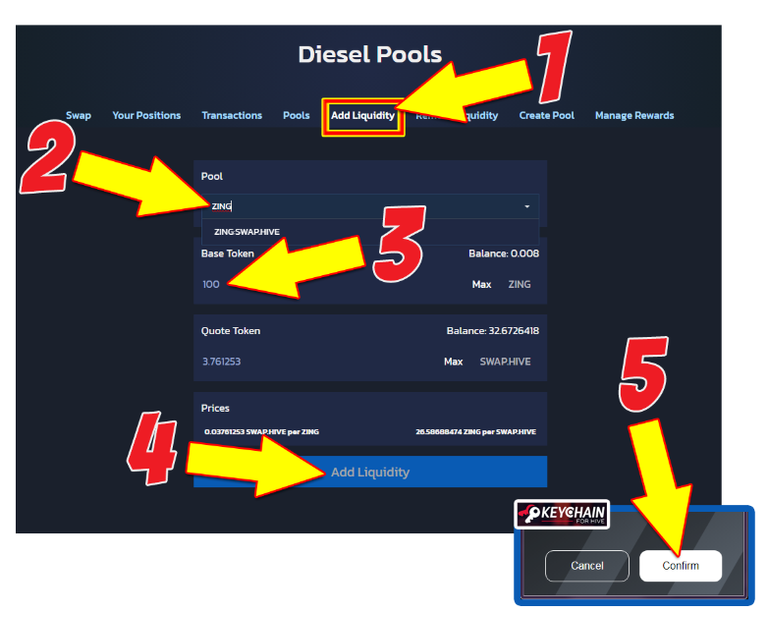
- the Add Liquidity section of BeeSwap.
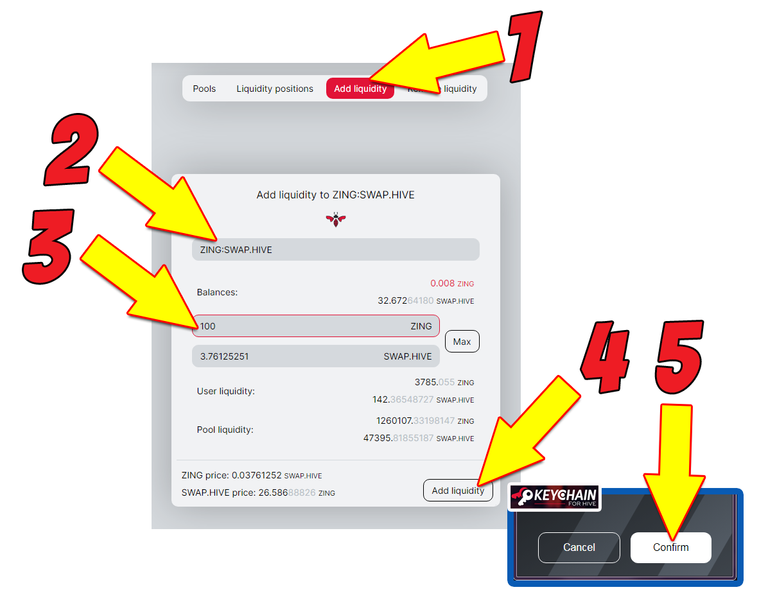
To remove liquidity from the ZING:SWAP.HIVE pool you can use:
- Remove Liquidity section of TribalDEX.
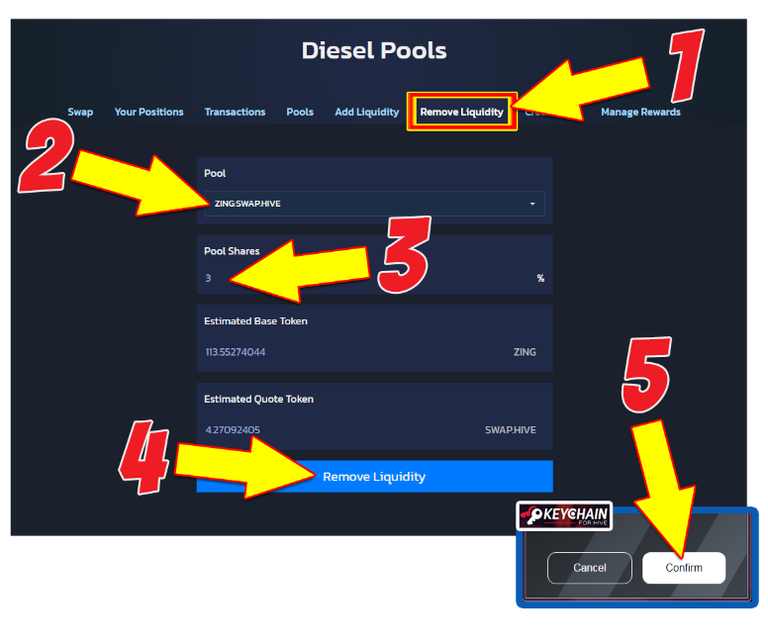
- the Remove Liquidity section of BeeSwap.
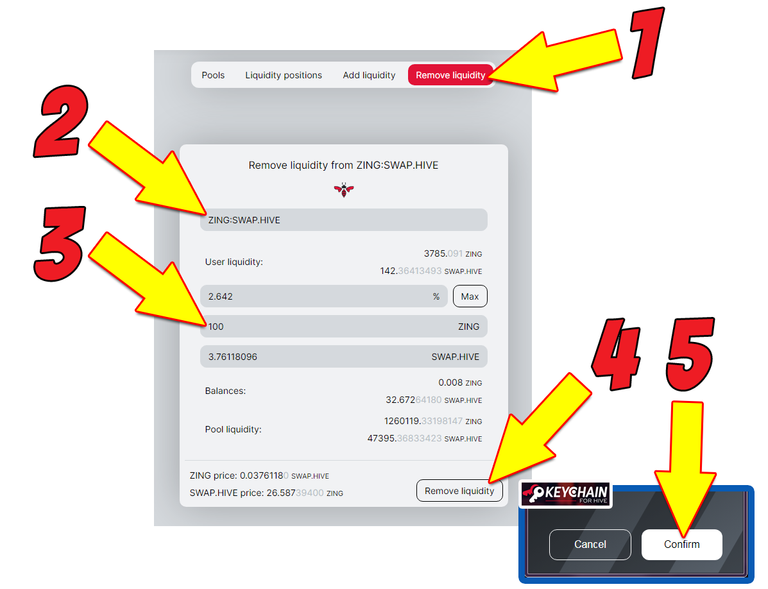
I prefer to use Beeswap because it has more options and provides more information about the Rewards of liquidity pools.
I use TribalDex instead to track earned fees.
If you have added liquidity in the pools of other blockchains you will be pleased to know that adding and removing liquidity in Hive Diesel pools is a 0-cost operation!

What is impermanent loss

The risk related to liquidity pools is the impermanent loss.
Impermanent loss is a loss that is realized:
- only when liquidity is removed from a pool.
- only if there has been a change in the value ratio of the tokens added as liquidity into the pool in the time interval between:
- the liquidity addition
- the removal of liquidity
To better explain the concept of Impermanent Loss I will show you some example cases:
1st Case: The tokens added into the pool had the same change in value between the time of adding liquidity and the time of removing liquidity.
| Example 1 | Example 2 | Example 3 |
|---|---|---|
| token A = +50% | token A = +0% | token A = -50% |
| token B = +50% | token B = +0% | token B = -50% |
| Impermanet Loss = 0% | Impermanet Loss = 0% | Impermanet Loss = 0% |
The 1st case is a possible but highly improbable case!
2nd Case: The tokens placed in the pool had a different change in value between the time of adding liquidity and the time of removing liquidity.
| Example 1 | Example 2 | Example 3 |
|---|---|---|
| token A = +20% | token A = +200% | token A = +500% |
| token B = -10% | token B = -40% | token B = -95% |
| Impermanet Loss = 1.03% | Impermanet Loss = 25.46% | Impermanet Loss = 81.89% |
The second case is obviously the most probable case!
You can have fun simulating and calculating the impermanent loss using one of the many online calculators such as: https://dailydefi.org/tools/impermanent-loss-calculator/
Now let me show you another example/case study and in this case I consider the ZING and SWAP.HIVE tokens.
At the time of writing this post:
- 1 ZING = $0.012
- 1 SWAP.HIVE = $0.346
If you add as liquidity $500 of ZING and $500 of SWAP.HIVE and at the time you remove the liquidity the value of the tokens is:
- 1 ZING = $0.008
- 1 SWAP.HIVE = $1
If you added $500 of ZING and $500 of SWAP.HIVE as liquidity and at the time you remove the liquidity the value of the tokens will be::
- 1 ZING = $0.008
- 1 SWAP.HIVE = $1
The impermanent loss will be = 21.95%
This means that you have lost 21.95% of the value you would have gained by simply holding the SWAP.HIVE and ZING tokens instead of putting them into the pool.
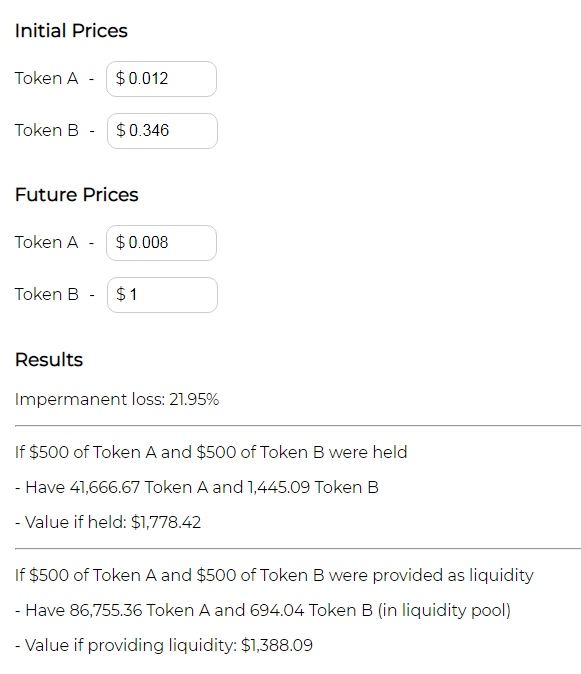
The question you are most likely asking yourself now is:
The question is logical and the answer is equally simple and is the subject of the next paragraph!

Why invest in a liquidity pool?

The impermanent loss may be uncovered, covered or surpassed by the rewards for liquidity providers.
The rewards for liquidity providers are:
- the fees generated by traders using the SWAP functionality of a pool (fees are always present in every liquidity pool)
- the rewards (not present in always pools and if present meausured with APR).
The reason why a liquidity provider adds liquidity to a pool is because it has assessed the value of the rewards receivable from the pool at a present and/or future value capable of covering and exceeding the risk of the impermanent loss!
Without fees and rewards only a fool would invest in a liquidity pool!

The financial analysis of my investment in the ZING:SWAP.HIVE pool after 18 days

In the previous paragraphs I showed the theory, in this paragraph I show the practice analyzing my investment in the pool ZING:SWAP.HIVE in which I have 726 SHARES (0.300%).
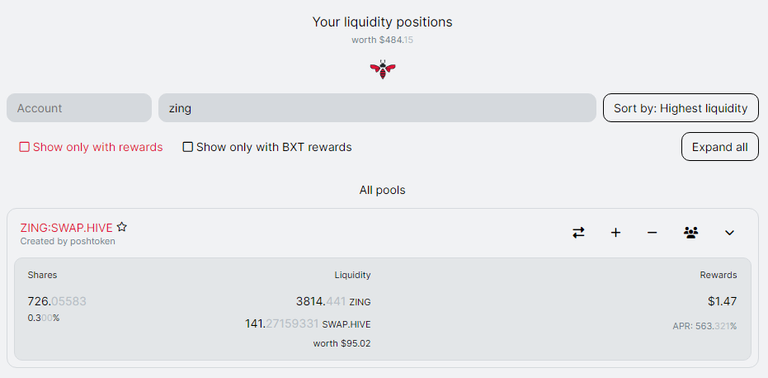
I added liquidity to the ZING:SWAP.HIVE pool over several days and created a table to mark all the transactions I have made to date and all the rewards I have received.
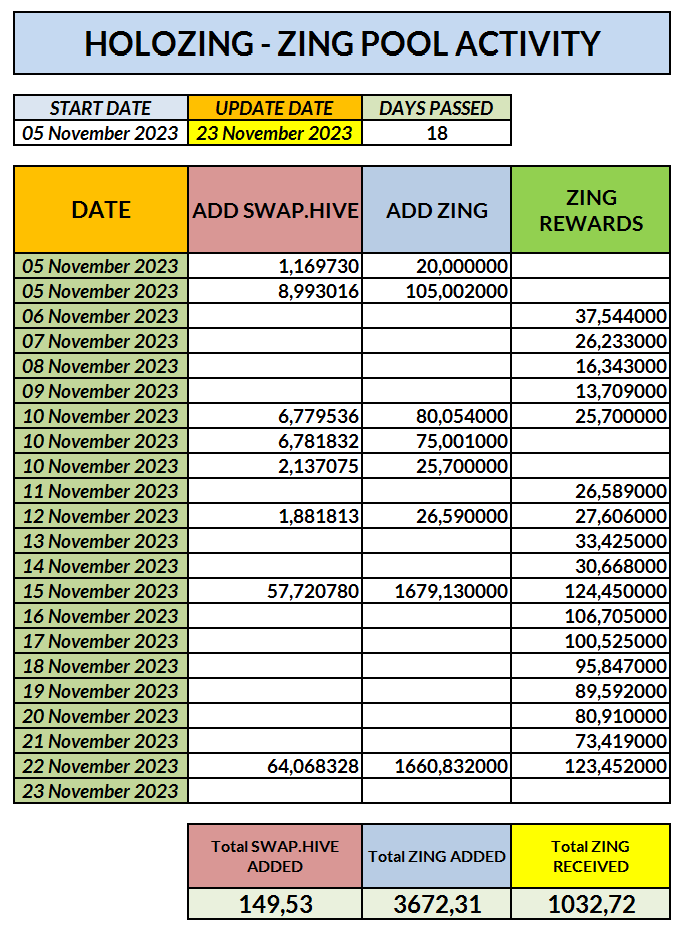
I started adding liquidity into the pool on November 5, 2023, and to date I have added:
- 149.53 SWAP.HIVE
- 3672.31 ZING
I have received 1032.72 ZING as a reward.

My Fees earned were:
- 2.98 ZING
- 0.15 SWAP.HIVE

Important Note: Earned Fees are added to the liquidity in the pool, rewards are sent into the Hive Engine Wallet.
If I had chosen to Hold instead of adding liquidity to the pool today I would have:
- 149.53 SWAP.HIVE
- 3672.31 ZING
- = Total Value: $93.28770
After 18 days as a liquidity provider if I decided to remove my liquidity from the pool today I would receive:
- 141.27 SWAP.HIVE
- 3814.44 ZING
- Total Value: $92.03843

As you can see from the table below the removal of my liquidity would produce today an Impermanent Loss = $1.24927
This means that in 18 days as a liquidity provider my liquidity in the pool has lost a value = -1.24927$ (impermanent loss)
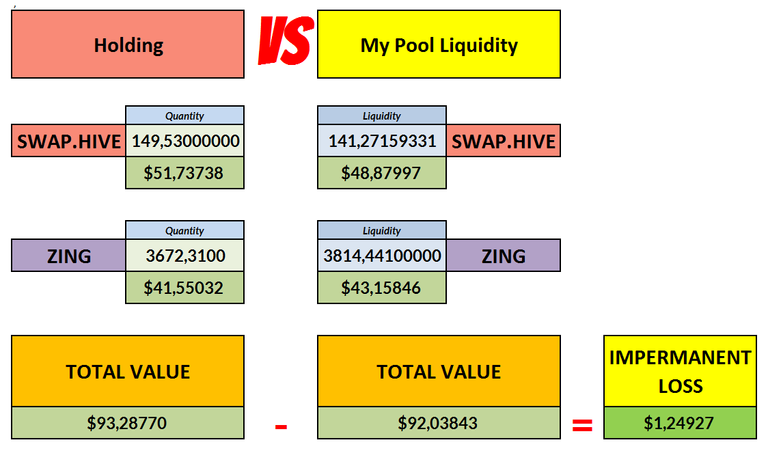
As a liquidity provider I received a total reward of 1032.72 ZING in 18 days whose market value (highest bid) = $11,685

The table below clearly shows that my choice to invest in the liquidity pool was a good choice from a financial point of view over the holding because:
- if I held today I would have a total value = $93.28.
- by investing in the pool I have a total value (ZING+SWAP.HIVE+Rewards) = 103.72$
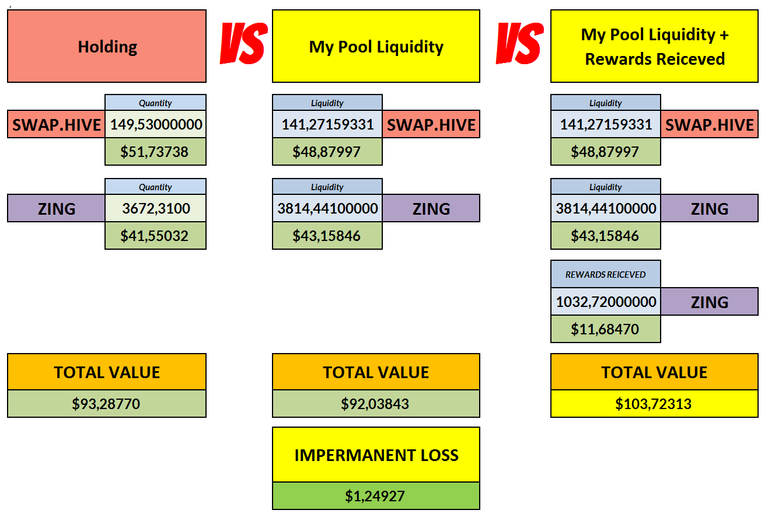
By investing in the liquidity pool ZING:SWAP.HIVE I covered and exceeded the impermanent loss and gained a profit over the holding.
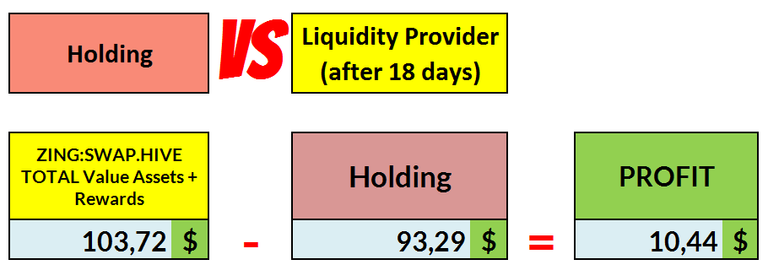

Final Considerations

The goal of my post is to help understand the mechanisms that govern a liquidity pool and in particular to understand what impermanent loss is and how to calculate it, and I hope I have succeeded.
Investing in a liquidity pool is the alternative choice to Holding and/or staking a pair of tokens.
If you have a pair of tokens that you do not intend to sell you should always consider and evaluate as a viable and alternative option to invest in a liquidity pool but you must always first understand the mechanics of how a liquidity pool works.
In my post I never mentioned the APR of a liquidity pool and I did so on purpose because I hope I made you understand that the APR of a liquidity pool is only one of the elements you need to evaluate before investing in a liquidity pool.
An APR of 2000% may be worth very little in the short term if the liquidity pool's rewards consist of tokens that have almost zero trading volumes and have no use cases other than selling and will have no other use cases in the future.
Evaluation of an investment in a liquidity pool must always be based on the evaluation of at least 5 elements:
- impermanent loss
- fees generated by traders
- rewards
- APR
- forecast on the future value of the token pair placed in the liquidity pool.
I hope I have given you useful information and thank you for taking the time to read this post :)



Holozing Game Site: https://holozing.com/
Hive Account: @holozing
Lite Paper: https://whitepaper.holozing.com/
Twitter/X: https://twitter.com/holozing
Discord: https://discord.gg/EGzdV9z8BG
ZING Market: https://tribaldex.com/trade/ZING
ZING:SWAP.HIVE pool:
ROADMAP: V1
Useful Posts:

Important Note

In any type of investment there is always a risk factor to evaluate and consider.
I am not a financial advisor and the information contained in this post is not financial advice.
Before investing in a blockchain-based game you should always do your own research and personal evaluations.





Holozing: Focus sulla Diesel Pool ZING:SWAP.HIVE + Impermanente Loss: Spiegazione ed Esempi + Il mio investimento da Liquidity Provider



Oggi ritorno a scrivere su HOLOZING che è un progetto di un Hive game in fase di sviluppo a cui sono molto interessato.

Il founder di Holozing è @acidyo e cliccando sul seguente link puoi vedere i membri del team che lavora a questo progetto: https://whitepaper.holozing.com/the-game/team
Anche se non è ancora possibile giocare a Holozing è possibile partecipare alla distribuzione dei token nativi di Holozing: i token ZING.
I token ZING vengono distribuiti tramite un claimdrop su base oraria e nella tabella seguente puoi vedere il quantitativo totale di token ZING distribuito giornalmente, mensilmente e annualmente.

Nel mio precedente post ho calcolato il migliore e più economico modo per guadagnare i token ZING in base alle diverse opzioni sceglibili e ho condiviso anche la mia strategia di base per accumulare i token ZING.
 | Post Link: Holozing: The Best and Cheapest Way to Earn ZING tokens! + My Strategy (ENG/ITA) |
|---|
Nel post di oggi il mio focus è sulla pool ZING:SWAP.HIVE e gli argomenti di questo mio post sono i seguenti:
- come aggiungere e rimuovere liquidità dalla pool ZING:SWAP.HIVE
- cos'è l'impermanent loss
- perchè investire in una liquidity pool?
- il mio investimento nella pool ZING:SWAP.HIVE

Come aggiungere e rimuovere liquidità dalla pool ZING:SWAP.HIVE

Hive è il mio progetto blockchain preferito perchè ha tante utilità.
Tra le tante utilità che ha Hive ci sono le liquidity pools che su Hive si chiamano anche Diesel Pools.
Se vuoi diventare un liquidity provider della pool ZING:SWAP.HIVE devi aggiungere liquidità alla pool = devi aggiungere due quantitativi di token ZING e SWAP.HIVE che hanno lo stesso valore di mercato.
Per aggiungere liquidità alla pool ZING:SWAP.HIVE puoi utilizzare:
- la sezione Add Liquidity di TribalDEX

- la sezione Add Liquidity di BeeSwap

Per rimuovere liquidità dalla pool ZING:SWAP.HIVE puoi utilizzare:
- la sezione Remove Liquidity di TribalDEX

- la sezione Remove Liquidity di BeeSwap

Se hai aggiunto liquidità nelle pool di altre blockchain ti farà piacere sapere che aggiungere e rimuovere liquidità nelle Hive Diesel pools è un'operazione a costo 0!

Cos'è l'impermanent loss

Il rischio collegato alle liquidity pools è l'impermanent loss.
L'impermanent loss è una perdita che si realizza:
- solo nel momento in cui si rimuove liquidità da una pool
- solo se c'è stata una variazione del rapporto di valore tra i token immessi come liquidità nella pool nell'intervallo di tempo tra:
- l'immissione di liquidità
- la rimozione di liquidità
Per spiegare meglio il concetto di Impermanent Loss ti mostro alcuni casi di esempio:
1° Caso: I token immessi nella pool hanno avuto la stessa variazione di valore tra il momento dell'aggiunta di liquidità e il momento in cui si rimuove la liquidità.
| Esempio 1 | Esempio 2 | Esempio 3 |
|---|---|---|
| token A = +50% | token A = +0% | token A = -50% |
| token B = +50% | token B = +0% | token B = -50% |
| Impermanet Loss = 0% | Impermanet Loss = 0% | Impermanet Loss = 0% |
Il 1° caso è un caso possibile ma altamente improbabile!
2° Caso: I token immessi nella pool hanno avuto una diversa variazione di valore tra il momento dell'aggiunta di liquidità e il momento in cui si rimuove la liquidità.
| Esempio 1 | Esempio 2 | Esempio 3 |
|---|---|---|
| token A = +20% | token A = +200% | token A = +500% |
| token B = -10% | token B = -40% | token B = -95% |
| Impermanet Loss = 1.03% | Impermanet Loss = 25.46% | Impermanet Loss = 81.89% |
Il secondo caso è ovviamente il caso più probabile!
Puoi divertirti a simulare e calcolare l'impermanent loss utilizzando uno dei tanti calcolatori online come ad esempio: https://dailydefi.org/tools/impermanent-loss-calculator/
Adesso ti mostro un'altro esempio/caso di studio e in questo caso prendo in considerazione i token ZING e SWAP.HIVE.
Nel momento in cui scrivo questo post:
- 1 ZING = 0.012$
- 1 SWAP.HIVE = 0.346$
Se aggiungi come liquidità 500$ di ZING e 500$ di SWAP.HIVE e nel momento in cui rimuovi la liquidità il valore dei tokens è:
- 1 ZING = 0.008$
- 1 SWAP.HIVE = 1$
L'impermanent loss sarà = 21.95%
Questo vuol dire che hai perso il 21.95% del valore che avresti ottenuto semplicemente holdando i token SWAP.HIVE e ZING invece di immetterli nella pool.

La domanda che con molta probabilità ti starai ponendo adesso è:
La domanda è logica e la risposta è altrettanto semplice ed è l'argomento del prossimo paragrafo!

Perchè investire in una liquidity pool?

L'impermanent loss può essere non coperto, coperto o superato dalle ricompense per i liquidity providers.
Le ricompense per i liquidity providers sono:
- le fees generate dai traders che usano la funzionalità SWAP di una pool (le fees sono sempre presenti in ogni liquidity pool)
- le rewards (non sempre presenti)
Il motivo per cui un liquidity provider aggiunge liquidità ad una pool è perchè ha valutato il valore delle ricompense ricevibili dalla pool di un valore presente e/o futuro capace di coprire e superare il rischio dell'impermanent loss!
Senza fees e senza rewards solo un pazzo investirebbe in una liquidity pool!

Il mio investimento nella pool ZING:SWAP.HIVE

Nei paragrafi precedenti ho mostrato la teoria, in questo paragrafo mostro la pratica analizzando il mio investimento nella pool ZING:SWAP.HIVE nella quale ho 726 SHARES (0.300%) = $95.02.

Ho aggiunto liquidità alla pool ZING:SWAP.HIVE in più fasi e ho creato una tabella per segnarmi tutte le operazioni che ho effettuato fino ad oggi e tutte le ricompense che ho ricevuto.

Ho iniziato ad aggiungere liquidità nella pool il 5 novembre 2023 e fino ad oggi ho immesso:
- 149.53 SWAP.HIVE
- 3672.31 ZING
Ho ricevuto 1032.72 ZING come ricompensa.

Le mie Fees guadagnate sono state:
- 2.98 ZING
- 0.15 SWAP.HIVE

Nota Importante: Le Fee Earned vengono aggiunte alla liquidità nella pool, le ricompense vengono inviate nel Hive Engine Wallet.
Se avessi scelto di Holdare invece di aggiungere liquidità alla pool oggi avrei:
- 149.53 SWAP.HIVE
- 3672.31 ZING
- = Total Value: 93.28770$
Dopo 18 giorni da liquidity provider se oggi decidessi di rimuovere la mia liquidità dalla pool riceverei:
- 141.27 SWAP.HIVE
- 3814.44 ZING
- Total Value: 92.03843$

Come puoi vedere dal prospetto seguente la rimozione della mia liquidità produrrebbe oggi un Impermanent Loss = 1.24927$
Questo vuol dire che in 18 giorni da liquidity provider la mia liquidità nella pool ha perso un valore = -1.24927$ (impermanent loss)

Come liquidity provider ho ricevuto una ricompensa totale di 1032.72 ZING in 18 giorni il cui valore di mercato (highest bid) = 11.685$

Il prospetto seguente mostra chiaramente che la mia scelta di investire nella liquidity pool è stata un'ottima scelta dal punto di vista finanziario rispetto all'holding perchè:
- se holdavo oggi avrei avuto un valore totale = 93.28$
- investendo nella pool ho un valore totale (ZING+SWAP.HIVE+Rewards) = 103.72$

Investendo nella liquidity pool ZING:SWAP.HIVE ho coperto e superato l'impermanent loss e ho ottenuto un profitto rispetto all'holding.


Considerazioni Finali

L'obiettivo del mio post è di aiutare a comprendere i meccanismi che governano una liquidity pool e in particolare a comprendere cos'è l'impermanent loss e come calcolarlo e spero di esserci riuscito.
Investire in una liquidity pool è la scelta alternativa all'Holding e/o allo staking di una coppia di token.
Se hai una coppia di tokens che non hai intenzione di vendere dovresti sempre considerare e valutare come opzione possibile e alternativa di investire in una liquidity pool ma devi sempre prima capire i meccanismi di funzionamento di una liquidity pool.
Nel mio post non ho mai nominato l'APR di una liquidity pool e l'ho fatto appositamente perchè spero di averti fatto comprendere che l'APR di una liquidity pool è solo uno degli elementi che devi valutare prima di investire in una liquidity pool.
Un APR del 2000% può valere molto poco nel breve periodo se le ricompense della liquidity pool sono costituite da token che hanno volumi di scambio quasi nulli e che non hanno casi d'uso oltre alla vendita e che non avranno altri casi d'uso in futuro.
La valutazione di un investimento in una liquidity pool deve sempre basarsi sulla valutazione di almeno 5 elementi:
- impermanent loss
- fees generate dai traders
- rewards
- APR
- previsione sul valore futuro della coppia di token immessi nella liquidity pool.
Spero che il mio post ti sia piaciuto e ti ringrazio per aver dedicato il tuo tempo alla lettura di questo post :)



Holozing Game Site: https://holozing.com/
Hive Account: @holozing
Lite Paper: https://whitepaper.holozing.com/
Twitter/X: https://twitter.com/holozing
Discord: https://discord.gg/EGzdV9z8BG
ZING Market: https://tribaldex.com/trade/ZING
ZING:SWAP.HIVE pool:
ROADMAP: V1
Useful Posts:

Nota Importante

In ogni tipologia di investimento c'è sempre un fattore di rischio da valutare e considerare.
Io non sono un consulente finanziario e le informazioni contenute in questo post non sono consigli finanziari
Prima di investire in un gioco basato su blockchain devi sempre fare le tue ricerche e le tue personali valutazioni.



Posted Using InLeo Alpha










